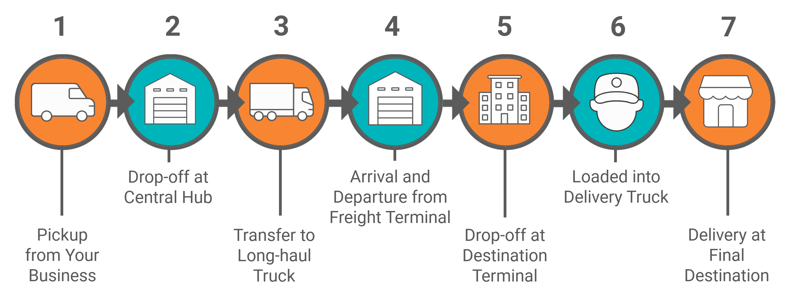LTL Shipping, also known as Less Than Truckload shipping, is a popular and cost-effective transportation solution for many small to medium-sized businesses. The process of LTL shipping or LTL freight delivery, as it's also referred to, might seem complex for new users. So, what exactly is LTL freight, and how does the journey of an LTL shipment unfold? In this comprehensive guide, we shed light on the key stages of the LTL freight shipping journey, to help you understand and leverage the benefits of LTL delivery
A common misconception about LTL freight is that it's collected from one location and delivered directly to another. In reality, an LTL freight shipment usually undergoes at least six forklift moves and is transported on a minimum of three different trucks before reaching its destination. This is because LTL freight shares trailer space with other consignments, creating a journey that includes multiple stops and requires detailed logistic planning.
Here's a step-by-step breakdown of an LTL shipping journey:

1. Pickup - The LTL freight journey begins and ends with Pickup and Delivery (P&D). Your shipment is collected from your premises by a local truck that also picks up other LTL shipments nearby. Your LTL freight is then transported to a nearby terminal.
2. Drop-off at Central Hub - Your LTL shipment is transported to a central hub or break bulk, where it is unloaded, sorted, and prepared for the next part of its LTL delivery journey.
3. Transfer to Long Haul Truck - In this part of the LTL shipping process, known as the line haul, your shipment is moved onto a long-haul truck along with other LTL shipments. This truck usually travels to another terminal, not the final destination.
4. Freight Terminal Arrival and Departure - The LTL freight usually doesn't travel directly from the break bulk to its end point. The goods are typically first dropped off at a freight terminal, where the LTL shipment is transferred and rerouted as necessary.
5. Drop-off at Destination Terminal - The long-haul truck arrives at the destination terminal, where your LTL freight is unloaded and prepared for loading onto the appropriate local delivery truck.
6. Loaded into Delivery Truck - Your LTL shipment is loaded onto a delivery truck also called last mile at the terminal, selected based on the specific needs of your freight.
7. Delivery - After a final short journey, your LTL freight reaches its destination!
Understanding the LTL shipping process helps in managing transit time expectations for both shippers and customers. Although LTL delivery times may be longer than Full Truckload shipping, the flexibility and cost savings offered by LTL shipping are significant benefits. Because of the extended transit times, it’s extremely important to find the ideal carrier, locate the most optimized, economic routes, and efficiently track your shipment.
With digital shipping platforms like MyCarrier, the process of quoting, routing, managing, and evaluating the entire LTL shipping journey becomes simplified. These platforms help optimize your LTL shipping experience, making it more efficient and cost-effective.
Given the longer transit times and increased handling, LTL freight is exposed to a higher risk of loss or damage, making Cargo insurance vital. Platforms like MyCarrier can provide easy, cost-effective insurance solutions for your LTL shipments, giving you peace of mind that your cargo is fully covered.
Understanding the intricacies of LTL shipping helps you make the best shipping decisions for your business. Tools like MyCarrier can streamline your LTL shipping process, saving you money and valuable time.
Here are some additional things to consider when shipping LTL:
Benefits of LTL Freight: LTL shipping offers numerous advantages, particularly for small and medium-sized businesses. These include cost savings, as you only pay for the truck space your freight occupies. It also enables improved efficiency, as the freight can be transported alongside other shipments heading in the same direction. Additionally, many LTL carriers offer services like liftgate pickup and delivery, inside pickup and delivery, and notification options, further enhancing the convenience of LTL shipping.
LTL Shipping and the Environment: LTL shipping can also be a more sustainable choice. By consolidating multiple shipments into a single truck, LTL shipping reduces the number of trucks on the road, leading to lower carbon emissions.
The Role of Technology in LTL Shipping: Technology is playing an increasingly significant role in LTL shipping. Digital platforms like MyCarrier are transforming the LTL freight journey, making it easier for shippers to quote, route, manage, and evaluate their shipments. Meanwhile, advancements in tracking technologies are improving transparency, allowing customers to track their shipments in real time.
LTL Shipping in a Post-COVID World: The COVID-19 pandemic has had a profound impact on the shipping industry, including LTL shipping. In response to changing market conditions, many LTL carriers have adapted their operations to ensure the safety of their staff and customers, while still meeting demand. For example, they have implemented contactless pickup and delivery procedures, and are making greater use of technology to manage their operations remotely.
Preparing for LTL Shipping: When preparing for LTL shipping, it's important to accurately measure and weigh your freight, as these factors will determine your shipping rate. It's also a good idea to package your freight securely to protect it during transit, as LTL shipments are typically handled multiple times before they reach their destination.
.png)
.png)
.png)